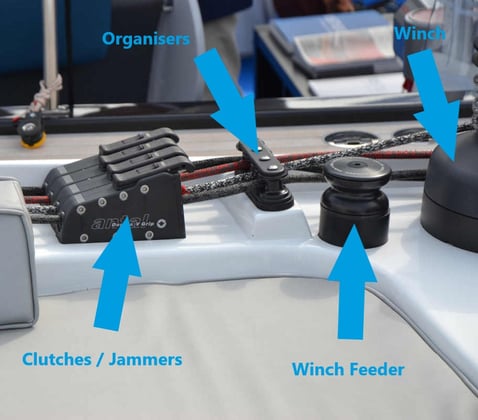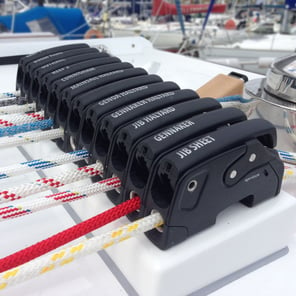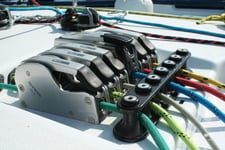
© Antal
What is the pit?
The pit is the nerve centre of a yacht, or at least all aspects that relate to sailing. The majority of lines on deck lead to the pit, including halyards, reef lines, tack lines, vang, outhaul and Cunningham to name some of the most common.
The pit or ‘snakepit’ (so named for obvious reasons), is therefore a bottleneck during manoeuvres and a good layout and good line management are crucial for fast hoists and tangle-free drops.
In this blog we outline the key components of the pit and some basic things to keep in mind.
Clutches
The high load lines arriving at the cockpit are typically terminated in a bank of clutches or jammers.

Image credit: Spinlock
Often referred to as the piano, due to its visual similarity to a piano keyboard, the clutch bank is perhaps the most important element to get right.
.jpg?width=296&name=My%20project-1%20(17).jpg)
There are several considerations here and an array of different products and brands to choose from. Sizing and holding power must be considered as well as the number of clutches needed and order of the lines running through them.
Jammers provide significantly more holding power than clutches but are typically larger, more expensive and require the load to be taken on a winch before release. Ceramic jaws for clutches are also a great upgrade from standard metal ones to improve holding power and reduce wear.
Smaller lines can be terminated in cam cleats placed in other locations adjacent to, or forward of, the main clutch bank.
Organisers & Winch feeders
Many yachts have some kind or organiser forward of the clutch bank to ensure a good line lead from the mast base into the clutches. Depending on the number of lines and the position of the cockpit winch or winches, additional organisers may be needed aft of the clutches. These allow the lines exiting the clutches to be led at a greater angle to reach the winch. Alternatively, a single winch feeder serves the same purpose but can be used by any of the lines.


Image credit: Spinlock
Winches
Many yachts will have one or two dedicated pit winches for halyards and control lines. The location of these is normally dictated by the design of the yacht. These winches should be sized according to the highest halyard loads.
Halyards bags
.jpg?width=296&name=My%20project-1%20(15).jpg)
Finally, the importance of halyard management. Halyards which are left loose on deck invariably become tangled or washed out the back of the cockpit. The cost and weight of investing in some halyard bags is easily justified by the peace of mind that comes from neatly stowed lines. As the old adage goes, ‘a tidy boat is a happy boat’. The bigger the boat, the more halyard length there is to stow. Ensure you have enough halyards bags or tie ups for all your lines.
Summary
Often overlooked, the pit is one area of your deck hardware where a little bit of planning and optimisation can go a long way to improving your sailing performance and removing frustrations.
- Think about the line layout to remove unnecessary friction from crossed lines and improve accessibility during manoeuvres
- If your clutches are slipping, consider upgrading to something with better holding power
- If you find yourself regularly leading a line from one clutch bank to the winch on the opposite side, add a winch feeder or organiser to reduce friction around the corner
- Halyard bags are well worth the investment for a tidy cockpit
If you have any questions about clutches and organisers, please feel free to email us at support@upffront.com, or click the link below to see our full range:


.jpg?width=279&name=My%20project-1%20(18).jpg)
